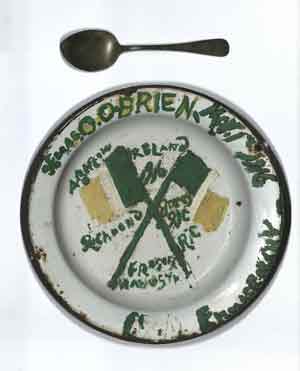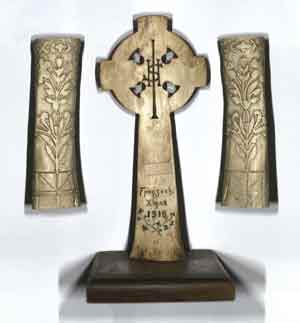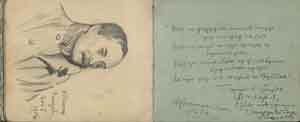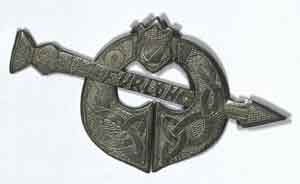‘ARCHIVES OF DETENTION’ IN WEXFORD COUNTY ARCHIVE FOR THE REVOLUTIONARY PERIOD
Published in Issue 4 (July/August 2022), Volume 30By Gráinne Doran
Wexford County Archive is home to an extensive range of private collections relating to the ‘decade of centenaries’. These range from the personal papers of some of the leaders of the 1916 Rising in Enniscorthy to others from County Wexford who commenced their active service during the War of Independence and Civil War periods. Each collection includes official documents, correspondence, diaries, photographs and, in many cases, a range of prison memorabilia.
One would expect to find archives of detention or prison memorabilia in a museum rather than in a local archive service, but an extensive collection of historical, military, domestic and maritime artefacts were transferred into the custody of Wexford County Archive in 2007 following the closure of the former Wexford County Museum, which had operated in Enniscorthy Castle from 1962 to 2006.
Prison correspondence offers a fascinating insight into the stark reality of incarceration while at the same time humanising the men and women in their portrayal of their concerns, hopes and ideals. In a letter from Laurence Lynch (an Irish teacher from Enniscorthy) to his wife Sighle, writing from Wakefield Prison on 25 May 1916, he provides a detailed account of his prison cell and daily routine, which is overshadowed by his desire to return to his family:
‘I’m sure you’re terrible lonely? It’s hard, but as Molly used to say (what can poor craturs do). I wish they’d hurry up & get thro’ with the trials or whatever they call them & let us home. I’m always thinking of the boat & you & the two boys asleep in stern etc. etc. I’d like to know what’s goin’ to make up for this forcible detention & destroying our home life’ (CM/1916/GEN/248).
In the earliest of a series of copy letters (11 May 1916) from Kathleen Browne (Rathronan Castle) to her mother from Mountjoy Prison following her arrest in May 1916, her account of prison life is positive—‘we are really very comfortable here, have good food, good beds, baths etc. and plenty of good books. It is very much like being in a Convent on retreat’ (WXCA/P105/9/1)—and a world apart from that of her friend Ellen (Nell) Ryan of Tomcoole, Taghmon, who was one of only a few female activists to be interned in England (Aylesbury Prison) in June 1916 and who wasn’t released from prison until October that year.
Other prison correspondence includes a series of letters from Seán (J.R.) Etchingham, writing from Lincoln Prison, 1918–19. In T.D. Sinnott’s letter to his mother from No. 2 Camp, Ballykinlar, Co. Down, c. December 1920, he expresses the hope that, although ‘times are still strenuous, there is every indication of an early improvement’.
Perhaps the most poignant prison correspondence in the county archive pertains to letters written by three young republicans—James Parle, John Crean and Patrick Hogan from Kyle flying column—to their families on the eve of their executions in Wexford Jail on 13 March 1923. In a letter from John Crean to his brother Patsy, he informs him that he is to be shot the following morning along with Jim Parle and Pat Hogan: ‘I pray earnestly to God he may give me the streght [sic] to face the firing squad like the rest of my Brave comerades [sic] gone before me’. He entrusts their mother to Patsy’s care—‘it is only now that I realise all the trouble and torment I have been to her during past years’.
As the War of Independence progressed and in the aftermath of the events of Bloody Sunday on 21 November 1920, internment camps were set up by the British to accommodate the large numbers of republicans arrested, including at Hare Park, the Curragh; Ballykinlar, Co. Down; and on Spike Island. The county archive holds a minute-book which documents the activities of the first GAA board established in Ballykinlar No. 2 Camp in May–November 1921. The minutes were written by Enniscorthy man Richard Whelan in his capacity as secretary of the GAA board in the camp.
Morale in the prison system was boosted by participation in cultural and sporting activities. An accompanying letter from ‘Pierce Purcell, Hon. Sec. “A” Block, Room 11, Internee Camp, Spike Island to the Commandant, Irish Internees, Ballykinlar Camp’, dated 15 September 1921, asks for the views of the men in Ballykinlar to a challenge issued by the men of Spike Island for a hurling match, for which Ballykinlar would have the option of selecting a team to play at Dublin: ‘The receipts after defraying teams’ expenses, including training, advertising, etc., to be devoted to the relief of the dependants of our fallen comrades’ (CM/P265). Money tokens that were used as internal currency in the camp are included in the denominations of 1d, 1s and £1.

Top: Brooch made by J. Foley during his imprisonment in Wexford Jail, 1923 (inscribed ‘M. Furlong’ on front).
Bottom: Plate and spoon belonging to Seamus O’Brien.
Another important prison series are surviving autograph books—those in the county archive were generated in 1916 (Frongoch) and in 1923 (Wicklow Jail). A digital copy of an autograph book owned by Commandant Seán Sinnott from Wexford town during his incarceration in Spike Island in 1921 was deposited recently and will be made available online shortly. These books are an invaluable resource for documenting some of the rank-and-file men and women who may otherwise have gone unrecorded. The books feature signatures of the prisoners, which are dated, and many are written as gaeilge—often a verse, a prayer, poems to republican martyrs, political ballads, sketches and drawings might be included. Other related archival material includes permits issued to members of the clergy for visiting prisoners from County Wexford in the various prisons and internment camps during the 1916–23 period.
By far the most visual series of prison memorabilia relates to pieces of handmade craftwork. Skills honed by the internees during their period of detention in the various prisons and camps resulted in the creation of beautifully fashioned pieces, including brooches, rings, Celtic crosses and macramé bags. The cultural awareness of the prisoners is evident, with many signing their names in Irish and using various Celtic Revival motifs and designs on the artefacts. Along with convict caps and other personal items, the craftwork is another important research resource when identifying active men and women from the period, particularly those who may not have featured in mainstream sources.
Gráinne Doran is Archivist with Wexford County Archive(www.wexfordcountyarchive.com, archivist@wexfordcoco.ie).



















